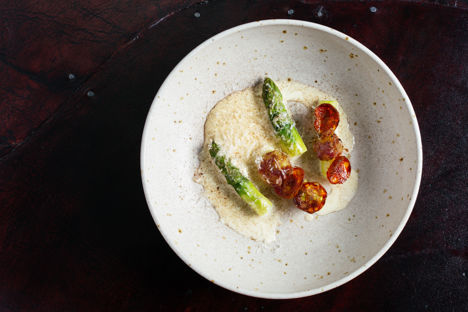
Mind to menu: Sat Bains’ asparagus with hollandaise and salami
Tom Shingler talks to two-Michelin-starred Sat Bains about the thought process behind one of the chef’s most seasonal dishes.
Mind to menu: Sat Bains’ asparagus with hollandaise and salami
Tom Shingler talks to two-Michelin-starred Sat Bains about the thought process behind one of the chef’s most seasonal dishes.
It sounds – and looks – so simple. Two spears of asparagus with a hollandaise sauce and a few slices of charcuterie on top. But of course, any dish cooked by Sat Bains and served at his eponymous restaurant is going to be hiding a few tricks up its sleeve. There are just two tasting menus – one seven-course, one ten-course – on offer at the restaurant, so each dish needs to be absolutely incredible. For Sat, that means showcasing exemplary cooking skills, offering something diners simply can’t get at home and championing ingredients that people won’t necessarily find in the shops. Asparagus with hollandaise and salami is something most of us could easily prepare at home, but Sat’s version is a completely different beast.
‘We use local Nottingham asparagus, an ingredient that’s only really in season for five or six weeks a year,’ he explains. ‘The aim is to intensify the flavour, so we blanch it in stock and butter, make a little emulsion, add house-made cured meats that are high in umami as well as Parmesan which is high in amino acids.’
Already, the mention of amino acids suggests Sat has done some serious research into the ingredients he works with. The balance of a dish (and how each of those dishes work together in a tasting menu) is at the forefront of the chef’s cuisine, and that means looking really, really closely at how different foods and flavours work together. A little tweak here and a small change there can easily take a dish from good to great.
‘For the asparagus we want to showcase it in a simple way, so we take two beautiful fat spears cooked in a classic emulsion with things like butter and lemon juice,’ says Sat. ‘We all know hollandaise and asparagus go really well together, so we add the sauce, but how can we heighten the flavours? We do that by adding air-dried chorizo and salami that we’ve cured for three months, which just begins to melt on top of the asparagus and adds a fatty element. We also infuse the hollandaise with hay for an extra herby note, then dust the dish with toasted hay for a fresh, farmyard flavour. So you’ve taken a simple combination – asparagus with hollandaise – and made it really intense with the hay and cured meats. I want people to see the dish and know what they’re going to get, but then the first mouthful is so intense and way more than they were expecting. I think that’s the aim for any chef.’
Hay is one of those subtle ingredients that appear on restaurant menus but rarely in the home kitchen. Plenty of chefs use it in their cooking but Sat goes one step further, treating hay as a flavour that can be adapted and changed to suit a dish. ‘We’ve had rabbits at the restaurant for ten years so I know what hay smells like, and how it can differ on a hot and cold day. Hay-baked chicken and hay-infused sauces taste incredible, but you’ve got to look more closely at it. Wet hay, dry hay, blowtorched hay and toasted hay will each give you a different flavour profile. You need to sub-section all these different types of hay and think about which one will work best. It’s the same with anything – when a recipe needs some acidity most people think of lemon juice. But acidity can come from plants, wines, vinegars; all sorts of things. Perhaps the lemon juice is too harsh and you don’t want the citrus flavour, so you use shallots instead. It’s endless.’
Click the link below to take a look at the recipe.

